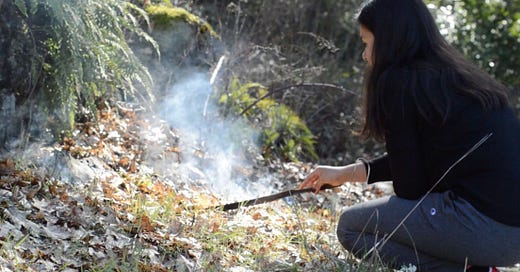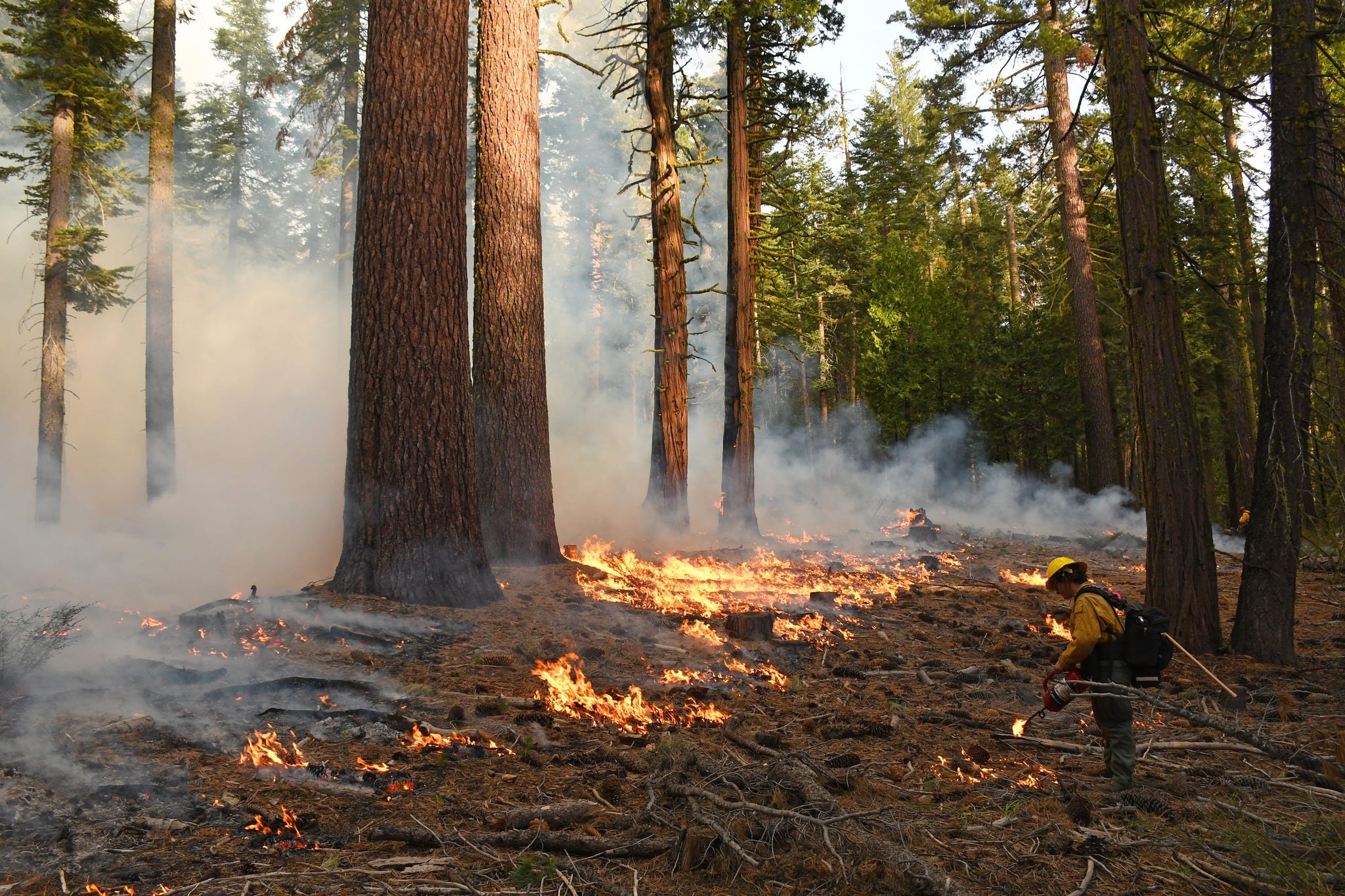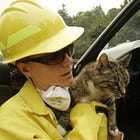Historic agreement affirms tribe's right to set good fire
Once labeled arsonists, the Karuk Tribe will perform burns for wildfire resilience and ecosystem enhancement. Plus, why tribes and scientists are pushing regulatory reform.
Karuk Tribe women no longer risk committing a crime for lighting fires that enhance the growth of hazel they use to weave their baby baskets. The tribe can now create clearings in forests using fire, to allow deer and elk freer passage and better forage. Using good fire, they can build large buffers of wildfire-resistant forests around their 120 villages in Northern California, without obtaining permits and environmental reviews.
Once targeted as arsonists for simply practicing their culture, the Karuk Tribe is leading the way for good fire, last week signing a first-of-its-kind agreement with the State of California under a new law meant to acknowledge tribal sovereignty while helping to build fire and climate resilience across the state. The pact acknowledges the tribe’s unceded rights to conduct burns at their discretion without cumbersome regulatory delays. More federally recognized tribes are expected to follow suit.

“Our ancestors’ relationship with fire is sacred intergenerational knowledge passed down since time immemorial,” said Russell “Buster” Atebery, Chairman of the Karuk Tribe, in a press release. “Our people have been hurting for over a century by fire suppression laws that have drastically impacted our resources and communities by preventing us from feeling safe to conduct cultural burns to manage our forests and steward our lands, as is our inherent responsibility. This victory acknowledges our true sovereignty and supports us in protecting our lands, just as our ancestors did.”
The Karuk Tribe’s ancestral territory covers a million acres in Northern California, near the border with Oregon, most of which is now managed by the U.S. Forest Service.
The tribe is recognized nationally for their controlled-burn expertise and “good fire” training program, called KTREX, which was launched in 2014. The tribe has frequently partnered with the Forest Service and The Nature Conservancy to share its knowledge with other fire practitioners. Even children are taught from a young age about the importance of using fire to build a healthy forest.
The agreement is a stark turnaround from how the tribe and its activities were treated 100 years ago.
In 1918, a district ranger for Klamath National Forest wrote a frustrated letter to his forest supervisor to report on the causes of the many fires in his jurisdiction. The letter first acknowledges that dried-up debris is accumulating in the forest as a result of the Forest Service’s fire suppression rule. Then, it proclaims the “cussedness” and “don’t give a damativeness” of “renegade whites and indians” who were lighting fires and declares that the only way to manage it was to “kill them off, every time you catch one sneaking around in the brush like a coyote, take a shot at them.”
As a result of such thinking, the West’s fire-dependent forests are now extremely overgrown and prone to catastrophic fire.
“… kill them off, every time you catch one sneaking around in the brush like a coyote, take a shot at them.”
— 1918 letter by district ranger F.W. Harley to his supervisor
Karuk Tribe archives
Tribes help with “all hands on deck” wildfire crisis
The Karuk’s agreement is expected to be just the first of many to come. Under a new state law, SB310, any federally recognized tribe in California can cement its own agreements to conduct permit-free burns at their discretion. The law also creates a liability fund to cover damages in case any burns run out of control, a longstanding concern with prescribed fire.
The news means more hands will be on deck in the West’s burgeoning wildfire emergency. Last year in California alone, wildfire burned a million acres. This landscape is wet in winter but extremely dry in summer, where dead wood, pine needles and forest debris don’t easily rot, but instead pile up and create tinderbox conditions.
Frequent, low-intensity fire is the only way to recycle nutrients to the soil in this ecosystem. High-intensity megafires, on the other hand, are not normal and are too much for even fire-evolved ecosystems to withstand. Megafires are fueled by a century’s worth of built-up, dried-out debris — the results of fire suppression laws that hobbled Native American cultural burns. Even old-growth trees and forests succumb to megafires: Last summer, the entire Ishi Wilderness in Northern California burned, old-growth stands and all.1
The Karuk’s ability to conduct burns is particularly welcome given the recent firings of thousands of Forest Service employees, a move that endangers wildfire preparedness across the country. While technically no “firefighting” staff were let go, many of those fired were involved in controlled burns, fire science and providing on-call firefighting support.
Despite this stupidity, wildfire prevention is receiving serious nationwide attention. Concern that overregulation prevents timely work is finally being heard. California Governor Gavin Newsom, a Democrat, last week declared a state of emergency so critical wildfire prevention work, including tree removal, is now exempt from the state’s landmark environmental law, the California Environmental Quality Act, or CEQA.
Meanwhile, the Fix Our Forests Act is headed to the Senate after passing the House on January 31. It aims to loosen the regulatory landscape to help streamline wildfire prevention projects. This bipartisan law, co-sponsored by California Democrat Scott Peters and Arkansas Republican Bruce Westerman, aims to remove hurdles posed by the National Environmental Policy Act (NEPA), a source of frustration for tribes, scientists, firefighters and land managers alike.
Plenty of environmentalists are in favor of the bill; it passed the House with Democratic support. It’s also supported by the National Congress of American Indians, Federation of American Scientists, Theodore Roosevelt Conservation Partnership, Citizens' Climate Lobby, and Rocky Mountain Elk Foundation, among others.2
You might have read fear-mongering headlines that proclaim “Trump wants to log your national park.” Just like there’s good fire, there’s such a thing as good logging. The two are often used in tandem for wildfire prevention. The scientific consensus is that forest thinning plus prescribed fire is the most effective way to reduce wildfire severity. Thinning beforehand also significantly increases the safety of prescribed fire, reducing the likelihood it will run out of control. Fix Our Forests aims to expand these existing methods that have proven successful over many decades.3
The aim of wildfire prevention bills is not clear-cutting. It’s protecting children’s lungs, clean air and water, wildlife, hunting and fishing grounds, skiing, biking and hiking trails, old-growth forests, tribal lands and villages, national forests and parks, timber lands and communities across the West. It’s about restoring ecosystems so they can welcome back good fire.
And yes, even national parks and old-growth forests are overgrown and direly need our care. Courts have agreed: See Park service can resume thinning trees in Yosemite for prescribed burns, 9th Circuit rules.
The case for regulatory reform
As it turns out, our beloved environmental laws are endangering the environment when it comes to wildfire prevention. Under these regulations, doing nothing is much easier than doing something, even if the result is catastrophic to air, water and endangered species.
The Karuk Tribe — along with many other tribes, scientists, firefighters and land managers — have long criticized the hurdles posed by NEPA, CEQA, Endangered Species Act and Clean Air Act. The tribe has published two “Good Fire” reports, in 2021 and 2024, laying out in excruciating detail how overregulation and lack of sovereignty recognition have created barriers to cultural burning4 and increased wildfire risk across California.
These laws can delay work by up to a decade, cost millions to permit, rely on understaffed agencies and even result in projects never getting done. The tribe argues that this red tape creates unintended consequences and ultimately endangers wildlife habitat and forests by preventing beneficial fire.
The morass of regulation is summarized well here in Good Fire II, (published before the passage of SB310, and the signing of last week’s historic agreement):
Instead, agencies assert to “permit” cultural burning, they must amend the relevant forest plan under the National Forest Management Act, develop environmental assessments under the National Environmental Policy Act and historic resource assessments under the National Historic Preservation Act, fulfill consultation and survey obligations under the Endangered Species Act, obtain air permits intended to implement the Clean Air Act, and require use of federally qualified burn bosses and other staff, even though no federal action should be involved. Imposition of these regulations—and indeed, the very idea of federal “control” over cultural burning—amounts to federal infringement on the exercise of a retained right, contrary both to the principles of Tribal sovereignty and self-governance and to the federal trust obligation to ensure the protection of Tribal rights.
This cumbersome situation is now a thing of the past, at least on Karuk tribal land.
Fire — both manmade and lightning-caused — is a natural, preexisting process in dry forests and ecosystems in the American West. Fire suppression, on the other hand, is unnatural. Many plants and animals are fire-dependent: Giant sequoias seeds need fire to germinate, black-backed woodpeckers only nest in burned areas. Other plants are “fire-evolved,” meaning they are fire resistant. For instance, a mature Jeffrey pine has a six-inch thick bark, and madrone and manzanita roots survive fire and send out shoots the following spring.
Research has shown that the Karuk Tribe alone may have lit up to 7,000 fires per year prior to European colonization.
The pre-existence of fire is foundational to the Karuk Tribe’s advocacy for changing NEPA and CEQA. It’s an important nuance when considering that national and state environmental laws were enacted to focus on “new” actions that may impact an ecosystem, such as a new dam or condominium project. Cultural burning is not new.
There’s been a lot of media hullabaloo accusing bills like the bipartisan Fix Our Forests Act of seeking to dismantle the Endangered Species Act, NEPA and CEQA. The act does not rewrite those laws but expands exemptions for wildfire prevention to ensure more work gets done in a timely manner. Tribes and scientists have been pointing out for years that the regulatory burden of these laws, as it relates to fire, have the potential to hurt, not help, endangered species.
“Compliance with the Endangered Species Act (ESA) has held up beneficial fire projects, even though fire restoration is often necessary to support the health of endangered and threatened species and the habitats on which they depend,” the authors of Good Fire II write.
Fire ecologists agree with these assessments. A paper published by Clark et al in Fire Ecology last year made the case that delays and expenses caused by NEPA, CEQA, Clean Air Act and Endangered Species Act are producing “perverse” outcomes. That is, they are endangering the environment more than protecting it, when it comes to wildfire. Take as an example the horrendous smoke from California’s yearly wildfires. The climate emissions from just one fire season can negate decades of statewide emissions reductions.
When it comes to endangered species, a megafire can wipe out a few hundred thousand acres of habitat that could have been protected by more frequent, smaller, low-intensity burns. Yet, inaction is easier and cheaper than action under current laws.
“Because the [Endangered Species Act] applies to federal action, but not inaction, agencies are not scrutinized for the negative impacts on endangered or threatened species when they increase wildfire severity and otherwise fail to actively steward the land,” Clark et al. write in Realignment of federal environmental policies to recognize fire’s role. “It is easier for agencies to engage in the passive land management practices (i.e., no action and monitoring) and continued fire suppression, both of which are at the root of the wildfire crisis, as opposed to proactively stewarding the land through reintroduction of beneficial fire.”
Then there is the monetary cost. An industry of consultants makes a living popping out million-dollar environmental assessments. At the Forest Service or Bureau of Land Management, “a single NEPA strike team costs between $500,000 and $1,000,000 annually,” Clark et al. note. Despite decades of science showing they work, fuels management projects (taking out dead wood and debris, small trees) are the most frequently litigated, adding more expense and delay, though most of these lawsuits fail.
“The magnitude and pace of reintroduction of beneficial fire is falling far short of what is necessary to address the current wildfire crisis in the western US. Though compliance with these policies is by no means the only barrier to expanding the use of beneficial fire, any delays can have a significant impact on the ground,” states the Clark et al. paper, which was funded by the Climate and Wildfire Institute.
The bottom line? Millions of acres of forest are going up in smoke because of bureaucratic red tape that suffocates wildfire prevention projects to death. Delay and doing nothing are imperiling the endangered species, forests, air and people all these laws are meant to protect.
A continent shaped by indigenous fire
Nearly every Native American community historically used fire to shape their landscape. Rather than domesticating animals, these peoples domesticated their prairies and forests, using fire to clear areas to attract abundant game. Bison roamed as far south as Georgia.
Here are a few excerpts from Charles Mann’s “1491: New Revelations of the Americas Before Columbus”:
“But the Indians maintained and expanded the grasslands by lighting huge areas on fire. Over the centuries, the burning created an intricate ecosystem of fire-adapted plant species dependent on indigenous pyrophilia.” (Page 5)
Relaying a Dutch colonist’s description of the yearly fires that lit up either side of the Hudson River: “Every fall, he remembered, the Haudenosaunee set fire to ‘the woods, plains, and meadows,’ to ‘thin out and clear the woods of all the substances and grass, which grow better the ensuing spring.’” (Page 283)
“Until Columbus, Indians were a keystone species in most of the hemisphere. Annually burning undergrowth, clearing and replanting forests, building canals and raising fields, hunting bison and netting salmon …” (Page 363)
“From the Atlantic to the Pacific, from Hudson’s Bay to the Rio Grande, the Haudenosaunee and almost every other Indian group shaped their environment, at least in part, by fire.”
— Charles Mann, “1491” (Page 284)
Further reading:
Karuk Tribe: Good Fire I (2021), and Good Fire II (2024)
California tribe enters first-of-its-kind agreement with the state to practice cultural burns (Los Angeles Times)
Stalled US Forest Service Project Could Have Protected California Town From Caldor Fire Destruction
Does thinning work for wildfire prevention? (High Country News): “In short, thinning and prescribed fire are critical for preserving Western forests.”
Related stories from Earth Hope:
Read more about Earth Hope and what inspired it. Visit earthhope.substack.com for more stories. Visit my Services page if you’re a writer who’d like some help figuring out Substack, with free editing for paid subscribers.
Wilderness areas receive the highest environmental protections of any land in the U.S., higher than national parks.
More organizations that support Fix Our Forests Act include:
American Forests
Grassroots Wildland Firefighters
Association of California Water Agencies
MegaFire Action
Western Fire Chiefs Association
The Nature Conservancy and Environmental Defense Fund have not published their stances on the act, that I can find, but have long supported ecological logging, not only as a carbon sequestration method to fight climate change, but also as a way to manage highly dense, unhealthy, fire-prone forests.
Another study published in Fire Ecology in 2024 reaffirmed that thinning produces overall benefits for reducing wildfire severity:
"While reducing stand density can lead to greater surface fuel drying (Kane 2021; Whitehead et al. 2006) and higher surface wind speeds (Bigelow & North 2012; Russell et al. 2018), our data provide clear evidence that the suppressing effect of crown fuel reduction far outweighed any enhancing effect of increased drying or higher windspeeds on fire behavior."
“Cultural burn” is not completely synonymous with “controlled burning” or “prescribed fire,” but there is some overlap in terms of ecosystem restoration and maintenance.









Wonderful job exposing the opportunities that now exist with streamlined regulations and the inclusion of the Karuk tribe members doing burns. Thank you!
Many thanks for sharing. Fire management is a vital tool in the management of these areas, and indigenous peoples are often the best managers